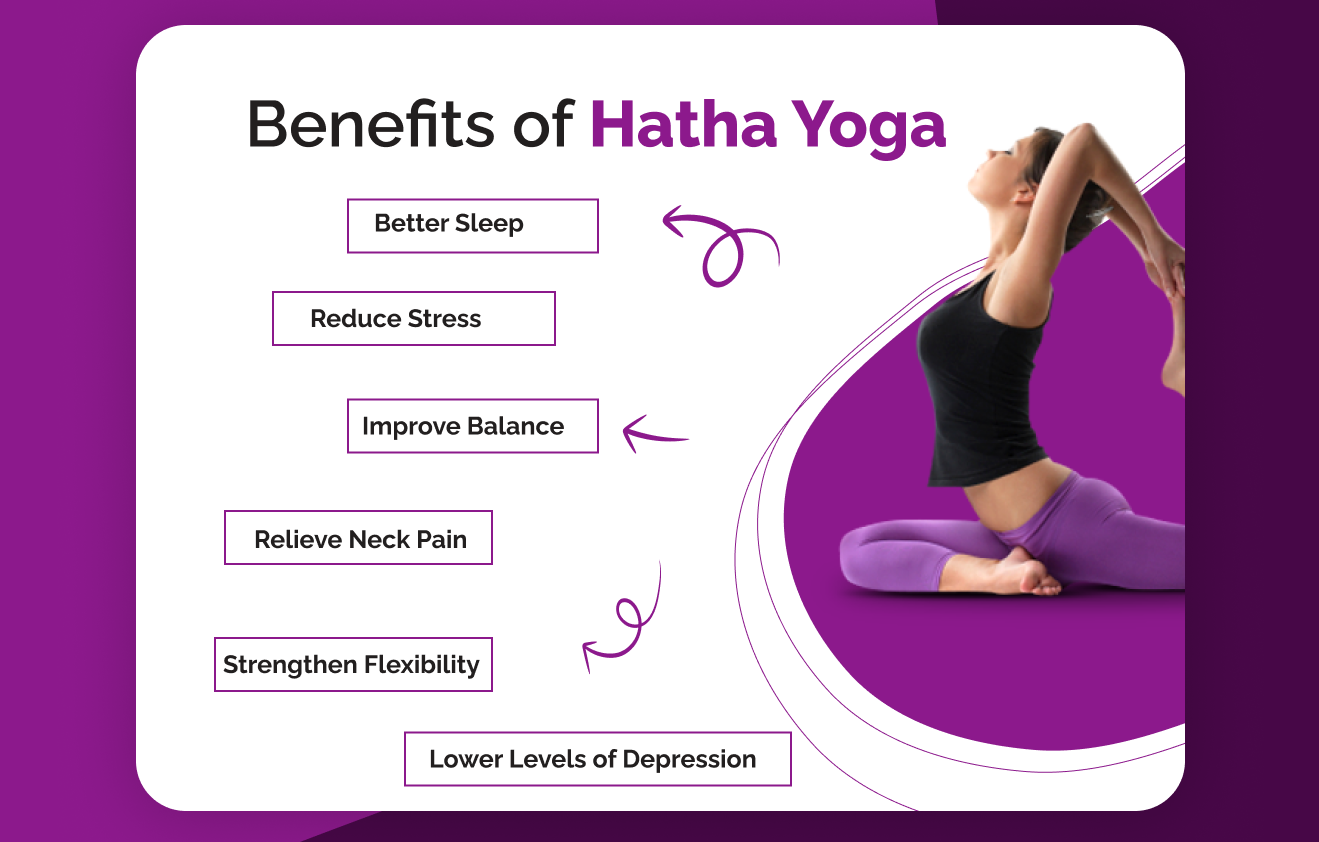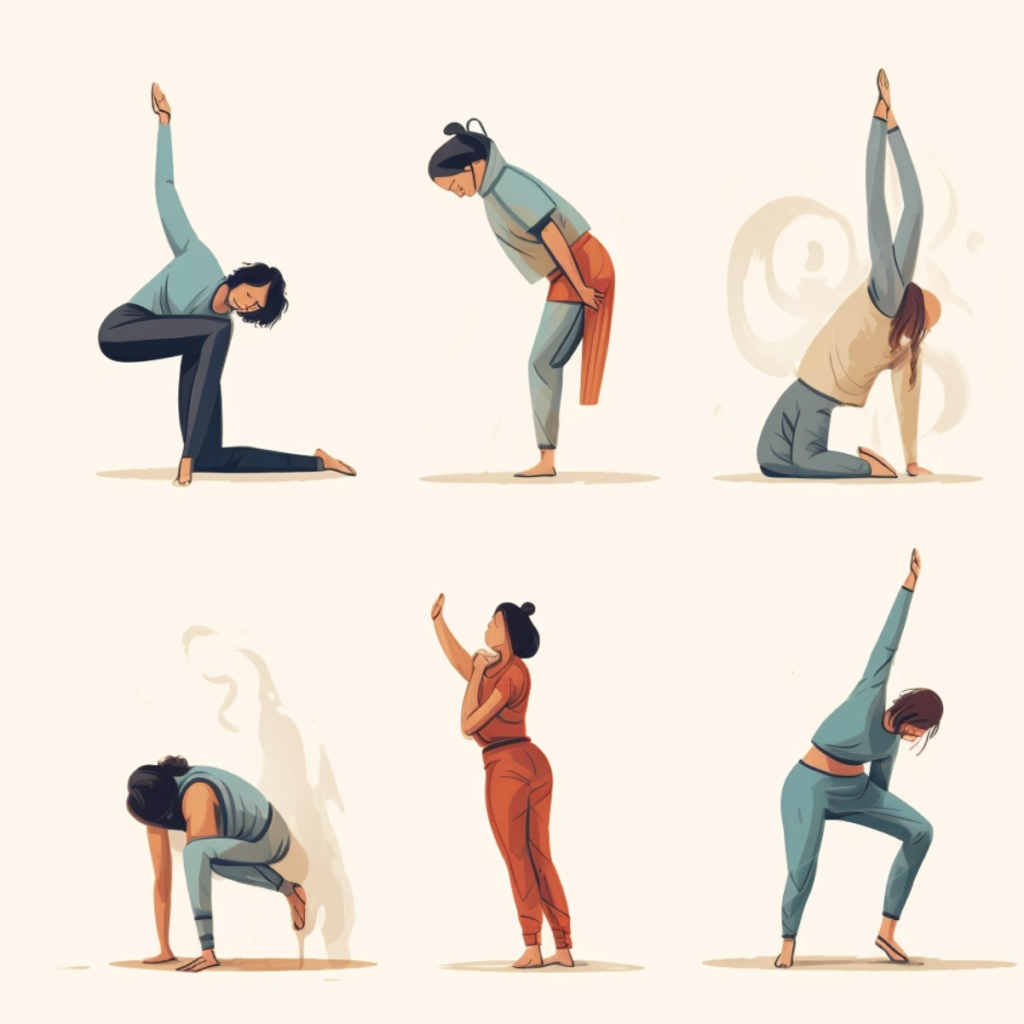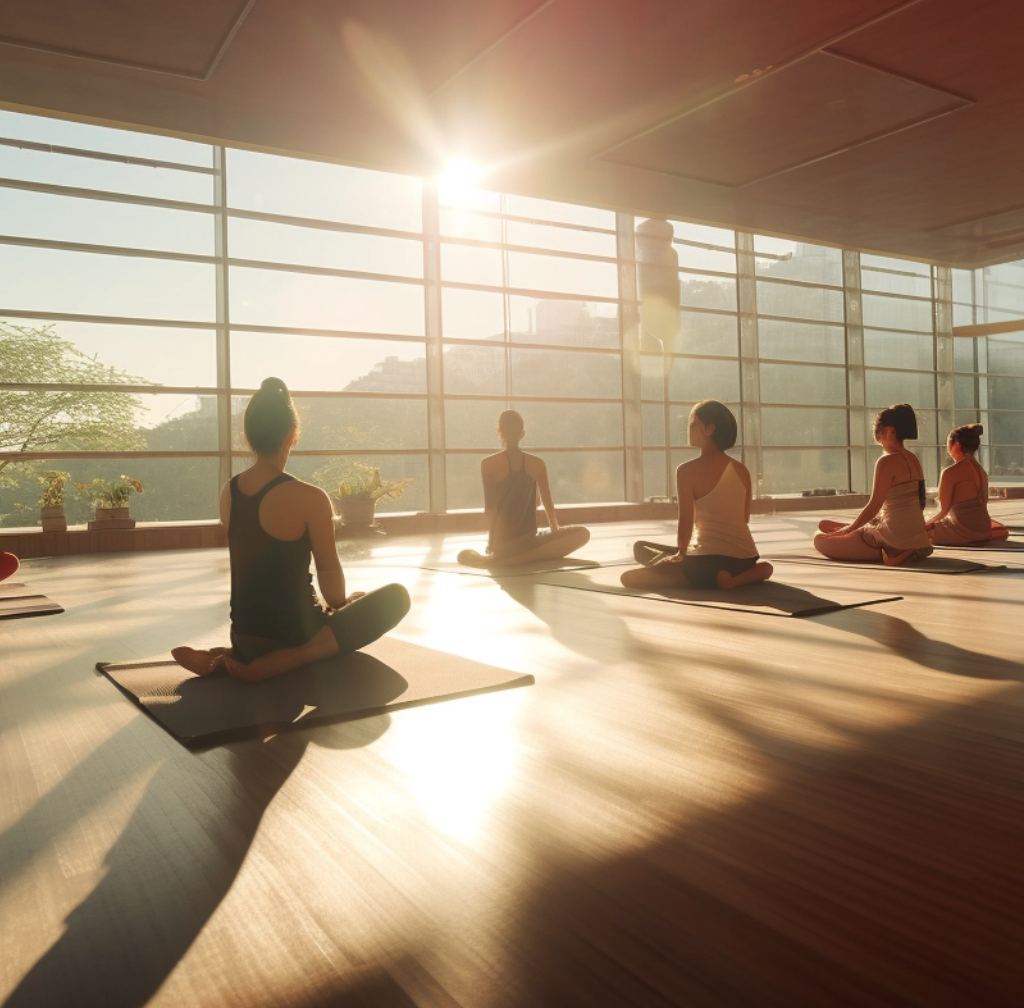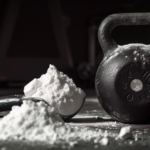Hatha Yoga has gained popularity as a preferred yoga style due to its benefits. Hatha Yoga benefits in enhancing strength, flexibility, and posture alignment, all while maintaining a gentle approach suitable for a wide range of individuals.
Hatha yoga, often the gateway to the vast world of yoga practices, might seem deceptively simple at first glance. But don’t underestimate its power. Beyond the gentle poses and mindful breathing lies a treasure trove of physical, mental, and emotional benefits that can transform your life.
Intrigued?
In this blog, we’ll embark on a journey to unveil the hidden gems of Hatha Yoga. We’ll explore:
What is Hatha Yoga?
Hatha Yoga is a traditional form of yoga that originated in ancient India. The term “Hatha” is derived from the Sanskrit words “ha” and “tha,” which mean sun and moon, respectively. This reflects the practice’s aim to balance and unite opposing forces, such as strength and flexibility, effort and surrender, or mind and body. Here’s a deeper dive into its characteristics:
Focus on Physical Practice:
- Unlike other yoga styles that might emphasize meditation or philosophical aspects, Hatha Yoga puts significant emphasis on physical postures (asanas) and breathing exercises (pranayama).
- Asanas involve holding various body positions to stretch, strengthen, and align the body.
- Pranayama techniques focus on controlling the breath to improve energy flow and mental clarity.
Accessibility and Variety:
- Hatha Yoga is generally considered beginner-friendly due to its focus on basic postures and techniques.
- It offers a wide range of postures catering to different levels of flexibility, strength, and experience.
- Modifications and variations are often encouraged to make postures accessible to all individuals.
Hatha Yoga can be a great way to improve your physical and mental well-being. If you're new to yoga, consider starting with a beginner-friendly Hatha class or seeking guidance from a qualified instructor.
7 Hatha Yoga Benefits

1. Better Sleep
Hatha Yoga benefits better sleep through its incorporation of stress-reducing asanas, calming breathwork (pranayama), and mindful meditation practices. The gentle stretching and relaxation achieved during specific poses help release physical tension, while intentional breath control calms the nervous system. Additionally, the meditative aspect of Hatha Yoga promotes mental quietude, reducing anxiety and creating an optimal state for rest. By integrating Hatha Yoga into a pre-sleep routine, individuals can experience improved sleep quality and a more tranquil transition into a restful night’s sleep.
2. Reduce Stress
Hatha Yoga provides significant benefits in reducing stress through its emphasis on controlled breathing (pranayama), mindful meditation, and calming postures (asanas). Engaging in Hatha Yoga practices helps activate the body’s relaxation response, leading to decreased levels of stress hormones and promoting a sense of calmness and balance in both the body and mind.
3. Improve Balance and Core Strength
One of the core physical benefits of Hatha Yoga lies in its ability to enhance balance and core strength. Through a series of static poses, the practice challenges the body’s stability, fostering a strong and centered foundation. This not only improves physical posture but also contributes to overall strength and vitality.
4. Relieve Neck and Back Pain
Hatha Yoga provides a therapeutic approach to addressing neck and back pain. The practice incorporates gentle stretches and poses that target areas prone to tension, promoting flexibility and relieving discomfort. Consistent practice may lead to long-term relief and a more resilient spine.
5. Lower Levels of Depression
Research suggests that Hatha Yoga may play a role in reducing symptoms of depression. The mindful and meditative aspects of the practice contribute to emotional well-being, providing practitioners with tools to navigate the challenges of daily life with greater resilience and positivity.
6. Strengthen Flexibility
Flexibility is a cornerstone benefit of Hatha Yoga, and regular practice can lead to increased suppleness in muscles and joints. Asanas are designed to gently stretch and lengthen the body, promoting flexibility and preventing stiffness. This enhanced flexibility not only supports physical health but also encourages a sense of fluidity and ease in daily movements.
7. Enhance Mindfulness
Beyond the physical benefits, Hatha Yoga serves as a gateway to mindfulness. By encouraging practitioners to focus on the present moment, the practice enhances awareness and concentration. This heightened mindfulness can have positive ripple effects, improving cognitive function and promoting a more conscious and intentional way of living.
HATHA YOGA POSE FOR BEGINNER
Hatha Yoga is a great way to improve your physical and mental well-being. It offers a wide range of poses that can be adapted to all levels of experience. Here are six beginner-friendly Hatha Yoga poses to get you started:
1. Mountain Pose (Tadasana):
- How to:
- Stand tall with your feet hip-width apart and rooted firmly on the ground.
- Distribute your weight evenly across your feet.
- Engage your core, drawing your belly button inwards and pulling your shoulders down and back.
- Relax your arms by your sides, palms facing your thighs.
- Lengthen your neck and gaze softly forward.
- Hold for 5-10 breaths.
- Benefits: Improves posture, increases body awareness, promotes balance and stability.
2. Downward-Facing Dog Pose (Adho Mukha Svanasana):
- How to:
- Begin on all fours with your hands shoulder-width apart and knees hip-width apart.
- Push your hips back and upwards, straightening your legs as much as possible without locking your knees.
- Press your heels firmly into the ground, engaging your core to keep your torso lifted.
- Relax your head and neck, allowing them to hang heavy between your shoulders.
- Hold for 5-10 breaths.
- Benefits: Stretches hamstrings, calves, and spine, strengthens arms and shoulders, improves circulation.
3. Child’s Pose (Balasana):
- How to:
- Kneel on the floor with your toes together and knees hip-width apart.
- Sit back onto your heels and rest your torso between your thighs.
- Lower your forehead onto the mat or onto a block placed in front of you.
- Extend your arms forward with palms facing down, or relax them alongside your body.
- Take slow, deep breaths and hold for as long as comfortable.
- Benefits: Relaxes the body and mind, provides gentle stretches for the back and hips, promotes emotional release.
4. Warrior II (Virabhadrasana II):
- How to:
- Step one foot back with your toes pointing outwards at a 45-degree angle.
- Bend your front knee so it forms a 90-degree angle with your ankle.
- Keep your back leg straight with your heel pushing back into the mat.
- Extend your arms out to the sides at shoulder height, palms facing down.
- Look over your front hand towards the horizon.
- Hold for 5-10 breaths and repeat on the other side.
- Benefits: Opens hips and strengthens legs, improves balance and coordination, increases focus and stability.
5. Triangle Pose (Trikonasana):
- How to:
- Stand with your feet wider than hip-width apart and turn your right foot outwards at a 90-degree angle.
- Turn your left foot slightly inwards.
- Bend your right knee, stacking your right ankle directly under your right hip.
- Reach your right hand down towards the floor or a block placed beside your foot.
- Extend your left arm upwards towards the ceiling, keeping your arm in line with your left ear.
- Gaze over your left hand towards the horizon.
- Hold for 5-10 breaths and repeat on the other side.
- Benefits: Stretches sides of the body, strengthens legs and core, improves flexibility and balance.
6. Cobra Pose (Bhujangasana):
- How to:
- Lie on your stomach with your hands flat on the floor beneath your shoulders, fingers spread wide.
- Press your forearms and palms into the mat as you slowly lift your chest and upper body off the ground.
- Arch your back slightly, keeping your gaze upwards.
- Engage your core and press your hips down towards the mat.
- Hold for 5-10 breaths and slowly lower yourself back down.
- Benefits: Opens the chest and shoulders, strengthens the back and spine, improves flexibility and posture.
Remember:
- These are just general guidelines, and it’s important to listen to your body and adjust the postures as needed.
- If you have any injuries or medical concerns, consult with a healthcare professional before practicing yoga.
- Don’t force yourself into any postures that cause pain.
- Focus on your breath and stay present in the moment
Tips for Beginners: Start with a few poses and gradually add more as you become more comfortable. Listen to your body and don't push yourself too hard. If you feel any pain, come out of the pose. You can use props such as blocks and blankets to modify the poses. It's helpful to practice with a qualified instructor who can provide guidance and support.
HOW HATHA Yoga DIFFERS FROM OTHER YOGA STYLES?

Hatha Yoga, while often considered a foundational style of yoga, differs from other styles in several key ways:
Focus:
- Hatha: Primarily focuses on physical postures (asanas) and breathing exercises (pranayama).
- Other styles: Some styles like Vinyasa and Ashtanga emphasize a flowing sequence of postures with synchronized breath. Others, like Yin and Restorative Yoga, prioritize deep stretches and relaxation. Meditation and philosophy may be more prominent in styles like Raja Yoga.
Intensity and Pace:
- Hatha: Generally slower-paced with longer holds in each posture, allowing for deeper alignment and breath awareness.
- Other styles: Some styles like Vinyasa and Power Yoga are faster-paced and more physically demanding. Others, like Yin and Restorative Yoga, are very slow and passive.
Accessibility:
- Hatha: Often considered beginner-friendly due to its basic postures and slower pace, allowing for modifications and variations for different abilities.
- Other styles: Some styles like Ashtanga and Iyengar Yoga require more strength and flexibility, while others like Kundalini Yoga can be more intense and not suitable for everyone.
Structure:
- Hatha: Classes often have a flexible structure, focusing on specific postures or themes based on the instructor’s approach.
- Other styles: Some styles like Ashtanga follow a set sequence of postures, while others like Vinyasa offer more freedom within a general flow.
Here’s a table summarizing the key differences:
| Feature | Hatha Yoga | Other Styles |
|---|---|---|
| Focus | Asanas & Pranayama | Can vary, some emphasize meditation, philosophy, etc. |
| Intensity | Slower paced, longer holds | Can vary, some faster paced, more intense |
| Accessibility | Beginner-friendly, with modifications | Can vary, some require more strength & flexibility |
| Structure | Flexible, based on instructor & theme | Can vary, some fixed sequences, others more open flow |
Hatha or Vinyasa Yoga – Which is Better?
There’s no simple answer to “Hatha or Vinyasa, which is better?” as it ultimately depends on your individual needs and preferences. Both styles offer fantastic benefits, but differ in key areas like pace, intensity, and flexibility. Here’s a breakdown to help you decide:
Hatha Yoga:
- Pace: Slower and more deliberate, allowing time to hold poses and focus on alignment.
- Intensity: Generally gentler and less physically demanding.
- Flexibility: Highly adaptable, with modifications available for various fitness levels.
- Focus: Emphasis on basic postures, breathing techniques, and meditation.
- Benefits: Increased flexibility, reduced stress, improved strength and balance, enhanced mindfulness.
- Good for: Beginners, those seeking relaxation and stress relief, individuals with injuries or limitations.
Vinyasa Yoga:
- Pace: Flowing and dynamic, linking postures together with breath in a continuous sequence.
- Intensity: Can be physically demanding and challenging, offering a good workout.
- Flexibility: Requires some existing flexibility and fitness for safe practice.
- Focus: Coordination of breath and movement, creating a flowing experience.
- Benefits: Increased cardiovascular health, improved strength and flexibility, boosted energy levels, stress reduction.
- Good for: More experienced individuals, those seeking a challenging workout, people who enjoy a dynamic practice.
Here are some additional factors to consider:
- Your personality: Do you prefer a slower, more meditative practice or a dynamic, flowing one?
- Your fitness level: Are you a beginner or do you have some yoga experience?
- Your goals: Are you looking to improve your flexibility, reduce stress, build strength, or get a workout?
- Your schedule: Do you prefer a shorter, faster-paced class or a longer, more meditative one?
Ultimately, the best way to choose is to try both styles and see which one you enjoy more. Many studios offer introductory classes for both Hatha and Vinyasa, so you can get a feel for each before committing.
What to Expect at Your First Hatha Yoga Class

- The atmosphere: Hatha yoga classes are typically calm and relaxed, with soft lighting and calming music.
- The instructor: Your instructor will guide you through the poses and provide modifications as needed. Don’t hesitate to ask questions if you’re unsure about anything.
- The warm-up: The class will usually begin with a gentle warm-up to prepare your body for the poses.
- The poses: The instructor will demonstrate each pose and then give you time to practice it. Don’t worry about being perfect – focus on your breath and listen to your body.
- The cool-down: The class will end with a cool-down and relaxation pose.
Conclusion
As we wrap up our exploration into the world of Hatha Yoga benefits, it’s clear that this ancient practice isn’t just about striking a pose—it’s a journey towards a healthier, more balanced life.
In the hustle and bustle of our daily routines, finding moments of tranquility becomes paramount. Hatha Yoga emerges as a gentle yet powerful ally, offering a myriad of advantages that extend beyond the physical realm.
So, unroll that yoga mat, take a deep breath, and let Hatha Yoga guide you to a space of serenity and self-discovery. With each stretch, each intentional breath, and each moment of mindfulness, you’re not just practicing yoga; you’re unwrapping a gift—an enduring source of vitality and balance in the beautiful tapestry of life.
Read Also – Misconception about yoga
FAQs Regarding Benefits Hatha Yoga
Is Hatha yoga good for losing weight?
While Hatha Yoga may not be primarily designed for weight loss, its practice can contribute to overall well-being, including improved metabolism and increased awareness of healthy lifestyle choices. For targeted weight loss, combining Hatha Yoga with cardiovascular exercises and a balanced diet is recommended.
How soon can one experience the benefits of improved balance through Hatha yoga?
The timeline varies for each individual. Regular practice, typically a few sessions per week, can lead to noticeable improvements in balance and core strength over a few weeks to months.
What is the best time to do Hatha yoga?
The ideal time for Hatha Yoga varies among individuals. Morning sessions are often preferred as they can energize and set a positive tone for the day. However, practicing in the evening can also help relax and unwind. Choose a time that aligns with your schedule and allows for a focused and unhurried practice.
Are there specific poses in Hatha yoga that target core strength?
Yes, Hatha yoga includes various poses like Plank, Boat Pose, and Bridge Pose that specifically engage and strengthen the core muscles, contributing to improved core strength.
Can Hatha yoga help in relieving chronic neck and back pain?
Yes, Hatha yoga incorporates therapeutic poses and stretches that target areas prone to tension, offering relief from chronic neck and back pain through increased flexibility and strength.
Is it necessary to practice Hatha yoga daily to experience its benefits?
The frequency of practice varies for individuals. While daily practice can offer consistent benefits, even a few sessions per week can lead to positive changes in physical and mental well-being.
What role does mindfulness play in the benefits of Hatha yoga?
Mindfulness is a fundamental aspect of Hatha yoga. The practice encourages present-moment awareness, enhancing concentration and focus, contributing to overall mental well-being.
Are there any age restrictions for practicing Hatha yoga?
Hatha yoga is generally suitable for individuals of all ages. However, it’s advisable for older adults or those with specific health concerns to consult with a healthcare professional before starting a new exercise regimen.
References
Latest Post







